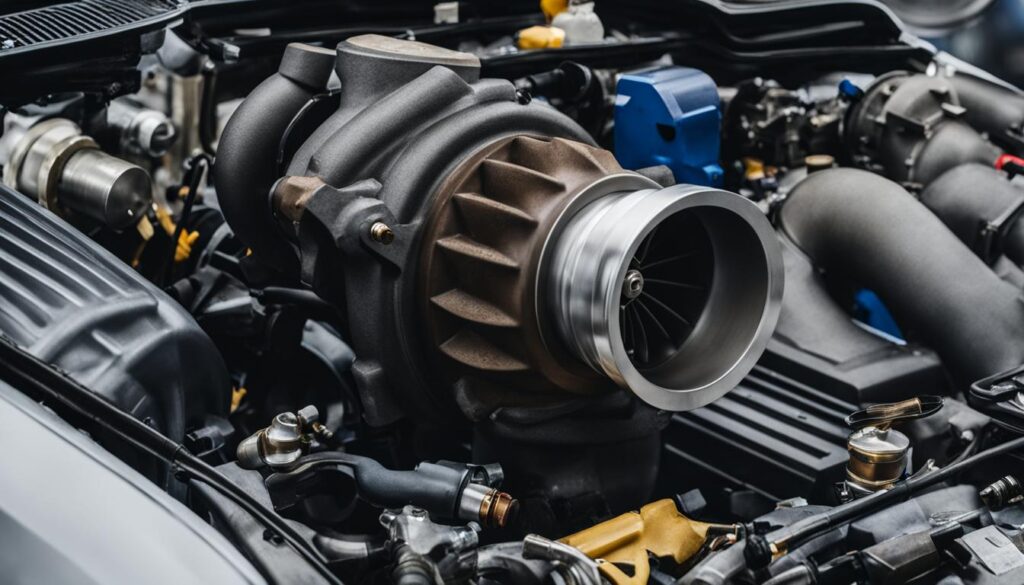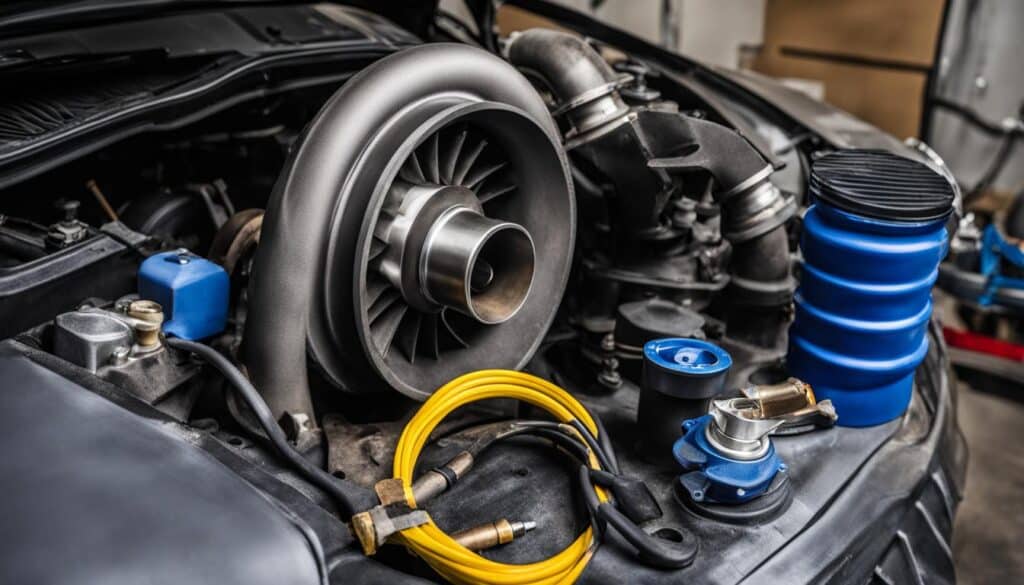As a car enthusiast, I know how thrilling it is to experience the power and performance of a turbocharged engine. However, turbocharger malfunctions can quickly turn that excitement into frustration. Understanding the common issues that can arise with turbochargers, as well as the proper fixes, is crucial for maintaining engine health and ensuring a smooth driving experience.
There are several key signs that indicate a turbocharger problem. One of the most noticeable is a loss of engine power or boost, which can make your vehicle feel sluggish and unresponsive. Engine noise, such as whining or grinding, is another red flag. Additionally, smoking exhaust and increased oil consumption may indicate that the turbo is failing. Keep an eye on your check engine warning lights and abnormal boost gauge readings as well.
Identifying the specific issue with your turbocharger requires a diagnostic check. Visual and benchtop inspections can reveal damage to components such as the compressor wheel, seal plate, and VNT mechanism. It’s essential to understand the underlying cause of the turbo failure to prevent future issues. This could include factors like oil starvation, oil contamination, foreign object damage, sticking VNT, or poor maintenance.
Preventing turbocharger problems starts with proper maintenance. Using the recommended synthetic oil and a quality oil filter can help prolong the life of your turbo. Regularly sampling the oil for contamination and repairing air leaks are also important steps. Lastly, always follow the correct shutdown procedure, as abrupt stops can contribute to turbocharger failure.
By staying vigilant and addressing turbocharger issues promptly, you can maintain optimal performance and efficiency in your engine. Let’s dive deeper into the causes of turbocharger damage and how to detect failures in the upcoming sections.
Key Takeaways:
- Turbocharger malfunctions can lead to engine damage and safety risks while driving.
- Common signs of turbo failure include power/boost loss, engine noise, smoking exhaust, warning lights, and abnormal boost gauge readings.
- Visual and benchtop inspections can help identify specific problems.
- Underlying causes of turbo failure include oil starvation, oil contamination, foreign object damage, sticking VNT, and poor maintenance.
- Preventing turbocharger problems involves using synthetic oil, quality oil filters, regular oil sampling, repairing air leaks, and following proper shutdown procedures.
Causes of Turbocharger Damage
Turbocharger damage can occur due to various reasons, and understanding these causes is crucial for preventing malfunctions and ensuring a longer lifespan for your turbo. Let’s explore the key factors that can lead to turbocharger damage:
1. Oil Starvation
Oil starvation, often caused by a drop in oil pressure or a delay in oil reaching the turbo, is a common culprit behind turbocharger faults. Insufficient lubrication can result in excessive friction and heat, leading to premature wear and failure of critical turbo components.
2. Oil Contamination
Contaminated oil is another significant cause of turbo failure. When the oil contains particles or debris, it can score the shaft and bearings, hinder proper lubrication, and negatively impact the seals. Regularly checking and maintaining the oil quality can help prevent turbocharger damage.
3. Overspeeding
Pushing the turbocharger beyond its limits is dangerous and can result in irreversible damage. While overspeeding can occur due to engine malfunction, it is often the consequence of poor maintenance or unauthorized performance upgrades. Operating the turbo within the manufacturer’s recommended specifications is vital for its longevity.
4. Foreign Object Damage
Foreign objects, such as dirt, dust, or broken engine components, can find their way into the turbocharger and cause severe damage. These objects can cause imbalances and impact damage to the compressor and turbine wheels, leading to reduced efficiency or complete failure of the turbo.
5. Sticking VNT
The Variable Nozzle Turbine (VNT) mechanism can suffer from sticking or restricted movement, often caused by carbon deposits. When the VNT is unable to adjust airflow correctly, it can lead to turbo failure. Proper maintenance, including regular cleaning, is essential for preventing this problem.
6. Poor Maintenance Practices
Inadequate maintenance practices can significantly contribute to turbocharger problems. Prolonged engine idling, hard acceleration from a cold start, hot engine shutdown, and revving the engine beyond safe limits can all put excessive strain on the turbo and lead to its untimely demise. Following the manufacturer’s maintenance guidelines is crucial for turbocharger longevity.
By understanding and addressing these causes of turbocharger damage, you can take proactive measures to prevent malfunctions and ensure the optimal performance of your engine.
Causes of Turbocharger Damage
| Cause | Description |
|---|---|
| Oil Starvation | Drop in oil pressure or delay in oil reaching the turbo |
| Oil Contamination | Presence of particles or debris in the oil |
| Overspeeding | Pushing the turbo beyond its limits |
| Foreign Object Damage | Ingress of dirt, dust, or broken engine components |
| Sticking VNT | Carbon deposits causing restricted VNT movement |
| Poor Maintenance Practices | Inadequate maintenance and operating practices |
Detecting Turbocharger Failures
Diagnosing turbocharger problems requires careful inspection and analysis. It is crucial to identify potential issues before they escalate and lead to catastrophic failures. There are several methods that can be employed to detect and assess turbocharger failures, including oil analysis, vibration analysis, thermal imaging, and ultrasound.
Oil Analysis
Oil analysis is a valuable tool for detecting potential turbocharger problems at an early stage. By analyzing the oil, it is possible to identify signs of oil starvation, oil contamination, and worn or damaged components. This preventive maintenance technique helps to uncover issues before they cause significant damage to the turbocharger.
Vibration Analysis
Another method for detecting turbocharger failures is vibration analysis. This technique involves analyzing the vibrations and oscillations within the turbocharger system to identify any imbalances, damaged blades, or worn bearings. While vibration analysis may only reveal problems in the later stages of failure, it is a useful diagnostic tool when combined with other analysis methods.
Thermal Imaging
Thermal imaging can be utilized to identify potential problems with inaccessible bearings. By comparing the thermal characteristics of both bearings on a common shaft, any abnormalities can be detected. This non-invasive technique allows for the early detection of bearing failure, which is crucial for preventing turbocharger malfunctions.
Ultrasound
In areas where accessibility is a challenge, ultrasound analysis can be employed to detect turbocharger failures. Ultrasound technology can capture high-frequency sound waves produced by the turbocharger, allowing for the identification of potential issues without the need for physical access. This technique proves to be highly valuable in diagnosing turbocharger problems in hard-to-reach areas.
By combining oil and vibration analysis, along with the utilization of thermal imaging and ultrasound technologies, it is possible to detect turbocharger failures with increased accuracy and efficiency. These diagnostic methods play a vital role in identifying underlying issues and ensuring the timely maintenance and repair of turbochargers, thus optimizing engine performance and preventing costly breakdowns.

| Diagnostic Method | Advantages | Limitations |
|---|---|---|
| Oil Analysis | – Identifies oil starvation and contamination – Detects worn or damaged components at an early stage |
– Requires regular oil sampling and analysis – Cannot detect all turbocharger issues |
| Vibration Analysis | – Detects balancing problems and damaged blades – Provides insights into bearing condition |
– May only reveal problems in later stages of failure – Requires specialized equipment and expertise |
| Thermal Imaging | – Identifies potential issues with inaccessible bearings – Non-invasive diagnostic technique |
– Requires proper interpretation of thermal patterns – Limited to detecting thermal abnormalities |
| Ultrasound | – Suitable for areas with limited accessibility – Non-invasive method for identifying issues |
– Requires specialized ultrasound equipment and training – Interpretation of ultrasound data can be complex |
Conclusion
Maintaining and troubleshooting turbochargers is essential for optimal engine performance and efficiency. By understanding the signs of turbocharger malfunctions and conducting regular inspections, potential issues can be detected early and repairs can be made to extend the life of the turbo.
Following proper maintenance practices such as using the recommended synthetic oil, changing the oil filter at recommended intervals, and checking for air leaks can help prevent turbocharger damage. It’s important to address any underlying problems that may contribute to turbo failure, such as issues with the fuel injection system, air filters, exhaust system, or lubrication. By taking proactive measures, turbocharger performance can be optimized, resulting in a more powerful and efficient engine.
In summary, turbocharger maintenance and troubleshooting are crucial for ensuring engine performance and efficiency. Regular inspections, proper maintenance practices, and addressing underlying problems can help prevent turbocharger issues and prolong the life of the turbo. By following these guidelines, you can enjoy the benefits of a well-maintained turbocharger and experience improved engine performance and efficiency.
FAQ
What are the common warning signs of turbocharger failure?
Common warning signs of turbocharger failure include engine power loss, engine noise, smoking exhaust, increased oil consumption, check engine warning lights, and abnormal boost gauge readings.
What are some specific problems that can be identified during a turbocharger inspection?
Specific problems that can be identified during a turbocharger inspection include damaged compressor wheel and seal plate, excess carbon buildup, and issues with the VNT mechanism.
What are the underlying causes of turbocharger failure?
The underlying causes of turbocharger failure can be oil starvation, oil contamination, foreign object damage, sticking VNT, or poor maintenance.
How can turbocharger problems be prevented?
Turbocharger problems can be prevented by using the proper synthetic oil, installing a quality oil filter, regularly sampling the oil for contamination, repairing air leaks, and following the correct shutdown procedure.
What are some common causes of turbocharger damage?
Common causes of turbocharger damage include oil starvation, contaminated oil, overspeeding, foreign object damage, sticking VNT, and poor maintenance.
How can turbocharger failures be diagnosed?
Turbocharger failures can be diagnosed through oil analysis, vibration analysis, thermal imaging, and ultrasound.
How can turbocharger maintenance and troubleshooting be done?
Turbocharger maintenance and troubleshooting involve conducting regular inspections, using the recommended oil and oil filter, checking for air leaks, and addressing any underlying problems that may contribute to turbo failure.




